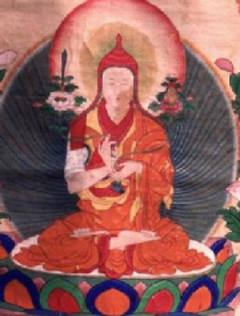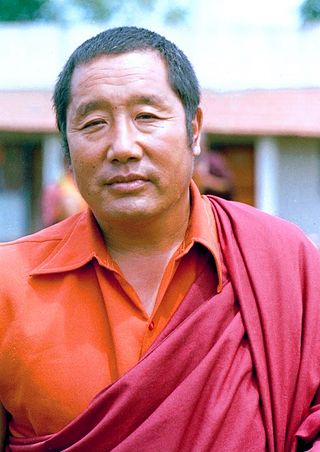
Padmasambhāva, also known as Guru Rinpoche and the Lotus from Oḍḍiyāna, was a tantric Buddhist Vajra master from medieval India who taught Vajrayana in Tibet. According to some early Tibetan sources like the Testament of Ba, he came to Tibet in the 8th century and helped construct Samye Monastery, the first Buddhist monastery in Tibet. However, little is known about the actual historical figure other than his ties to Vajrayana and Indian Buddhism.

Zanskar, Zahar (locally) or Zangskar, is a tehsil of Kargil district, in the Indian union territory of Ladakh. The administrative centre is Padum. Zanskar, together with the neighboring region of Ladakh, was briefly a part of the kingdom of Guge in Western Tibet. Zanskar lies 250 km south of Kargil town on NH301.

Jamgön Kongtrül Lodrö Thayé, also known as Jamgön Kongtrül the Great, was a Tibetan Buddhist scholar, poet, artist, physician, tertön and polymath. He is credited as one of the founders of the Rimé movement (non-sectarian), compiling what is known as the "Five Great Treasuries". He achieved great renown as a scholar and writer, especially among the Nyingma and Kagyu lineages and composed over 90 volumes of Buddhist writing, including his magnum opus, The Treasury of Knowledge.

Jamyang Khyentse Wangpo, also known by his tertön title, Pema Ösel Dongak Lingpa, was a teacher, scholar and tertön of 19th-century Tibet. He was a leading figure in the Rimé movement.

Kyabjé Drubwang Padma Norbu Rinpoche, 1932 – 27 March 2009, was the 11th throneholder of the Palyul Lineage of the Nyingma school of Tibetan Buddhism, and said to be an incarnation of Vimalamitra. He was widely renowned in the Tibetan Buddhist world as a master of Dzogchen. He was one of a very few teachers left from his generation who received all his training in Tibet under the guidance of what Tibetan Buddhists consider to be fully enlightened teachers.

Spiti is a high-altitude region of the Himalayas, located in the north-eastern part of the northern Indian state of Himachal Pradesh. The name "Spiti" means "The middle land", i.e. the land between Tibet and India. Spiti incorporates mainly the valley of the Spiti River, and the valleys of several rivers that feed into the Spiti River. Some of the prominent side-valleys in Spiti are the Pin valley and the Lingti valley. Spiti is bordered on the east by Tibet, on the north by Ladakh, on the west and southwest by Lahaul, on the south by Kullu, and on the southeast by Kinnaur. Spiti has a cold desert environment. The valley and its surrounding regions are among the least populated regions of India. The Bhoti-speaking local population follows Tibetan Buddhism.
The traditional dances of Himachal Pradesh are very complicated. These dances are a vital part of tribal life. It reflects the culture and the tradition of Himachal. Hardly any festivity there is celebrated without dancing. Dance forms such as Nati are performed all over the region.

Jetsunma Ahkon Lhamo is a tulku within the Palyul lineage of the Nyingma tradition of Tibetan Buddhism. She gained international attention when she, a western woman, was enthroned as a reincarnated lama. Since the mid-1980's she has served as spiritual director for Kunzang Odsal Palyul Changchub Choling, a Buddhist center in Poolesville, Maryland, which includes a large community of western monks and nuns. She also founded a center in Sedona, Arizona, U.S.A., and has small communities of students in California and Australia. Ahkon Lhamo has been described by her teachers, Tibetan lamas Penor Rinpoche, Gyatrul Rinpoche, as well as others such as Jigme Phuntsok, as a dakini or female wisdom being.

Kathok Monastery, also transliterated as Kathog, Katok, or Katog, was founded in 1159 and is one of the "Six Mother Monasteries" in Tibet of the Nyingma school of Tibetan Buddhism, built after Samye Monastery. It is located in Payul, Garzê Prefecture, Sichuan, China, in the region traditionally known to Tibetans as Kham.
Ganden Choeling Nunnery or Geden Chöling is a Tibetan Buddhist vihara for Buddhist nuns in Dharamshala, India. It is near the monastery in which the 14th Dalai Lama resides.
The Eight Garudhammas are additional precepts required of bhikkhunis above and beyond the monastic rule (vinaya) that applied to monks. Garu literally means "heavy" and when applied to vinaya, it means "heavy offense that entails penance (mānatta) consisting of 2 weeks" as described in garudhamma rule No. 5. The authenticity of these rules is contested; they were supposedly added to the (bhikkhunis) Vinaya "to allow more acceptance" of a monastic Order for women, during the Buddha's time. They are controversial because they attempt to push women into an inferior role and because many Buddhists, especially Bhikkhunis, have found evidence that the eight Garudhammas are not really the teachings of Gautama Buddha.

Lochen Rinchen Zangpo, also known as Mahaguru, was a principal lotsawa or translator of Sanskrit Buddhist texts into Tibetan during the second diffusion of Buddhism in Tibet, variously called the New Translation School, New Mantra School or New Tantra Tradition School. He was a student of the famous Indian master, Atisha. His associates included (Locheng) Legpai Sherab. Zangpo's disciple Guge Kyithangpa Yeshepal wrote Zangpo's biography. He is said to have built over one hundred monasteries in Western Tibet, including the famous Tabo Monastery in Spiti, Himachal Pradesh, Poo in Kinnaur and Rinchenling monastery in Nepal.
The Second Beru Khyentse, born Thupten Sherap is a lineage holder of the Karma Kagyu school of Tibetan Buddhism and the third reincarnation of Jamyang Khyentse Wangpo (1820–1892).

Buddhism in the Himachal Pradesh state of India of has been a long-recorded practice. The spread of Buddhism in the region has occurred intermediately throughout its history. Starting in the 3rd century BCE, Buddhism was propagated by the Maurya Empire under the reign of Ashoka. The region would remain an important center for Buddhism under the Kushan Empire and its vassals. Over the centuries the following of Buddhism has greatly fluctuated. Yet by experiencing revivals and migrations, Buddhism continued to be rooted in the region, particularly in the Lahaul, Spiti and Kinnaur valleys.
Sakyadhītā International Association of Buddhist Women is a 501(c)3 nonprofit organization founded in 1987 at the conclusion of its first conference and registered in California in the United States in 1988. Sakyadhītā holds an international conference every two years, bringing together laypeople, nuns, and monks from different countries and traditions around the world.

Kindo Baha, also known as Kinnu Bāhā, Kindol Bāhāl or Kimdol Bāhāl, is a vihara in Kathmandu which was the hub for the resurgence of Theravada Buddhism in Nepal from the 1920s to the 1940s.

Karma Lekshe Tsomo is a Buddhist nun, scholar and social activist. She is a professor at the University of San Diego, where she teaches Buddhism, World Religions, and Dying, Death, and Social Justice. She is co-founder of the Sakyadhita International Association of Buddhist Women and the founding director of the Jamyang Foundation, which supports the education of women and girls in the Himalayan region, the Chittagong Hill Tracts of Bangladesh, and elsewhere. She took novice precepts as a Buddhist nun in France in 1977 and full ordination in Korea in 1982.

Nimmu–Padum–Darcha road (NPDR) or Zanskar Highway is a road under construction between the Indian union territory of Ladakh and the state of Himachal Pradesh, passing through the region of Zanskar. It connects Nimmu in the Indus Valley to Padum, the capital of Zanskar, to Darcha village in Lahul and Spiti. It provides an alternative to the Leh–Manali Highway in linking Ladakh with the rest of India. It is being built by the Border Roads Organisation (BRO) of the Indian army. Construction of road is expected to be completed by late 2023. The already completed Atal tunnel and the proposed unidirectional-twin-tube total-4-lane Shingo La Tunnel which is expected to be completed by 2025 will provide all weather connectivity and reduce the Manali to Kargil distance by 522 km.
Tobdan is a historian and linguist from Himachal Pradesh, India. He is noted for his work on the cultural traditions, histories, and languages of the Lahaul and Spiti district, and some neighboring regions.
Tshering Dorje was a cultural historian from Himachal Pradesh, India. He was regarded as an authority on the cultural traditions and histories of the Lahaul and Spiti district and some neighboring regions. He also played an important role in bringing about the construction of the 9.02 km-long, high-altitude Atal Tunnel.












